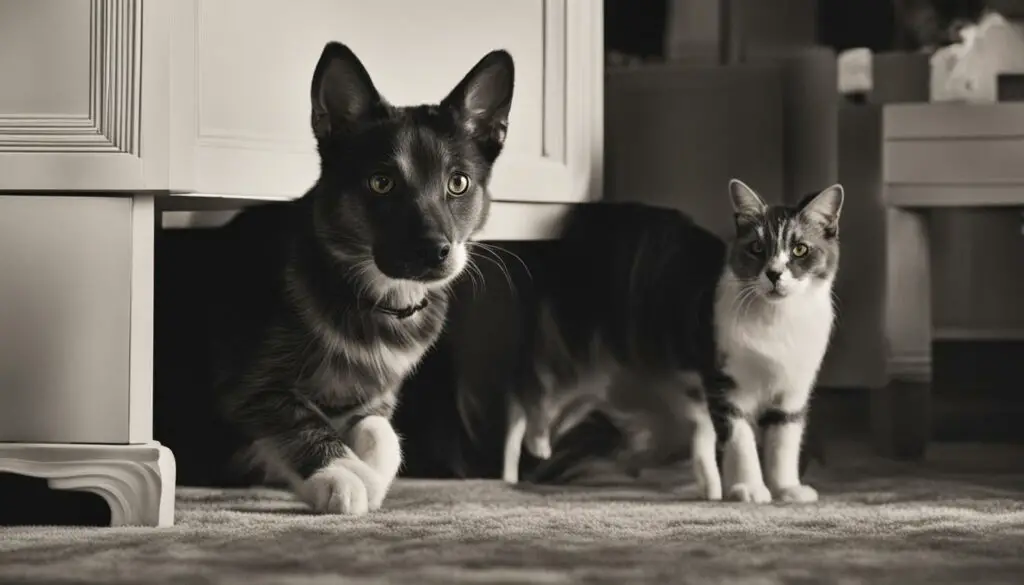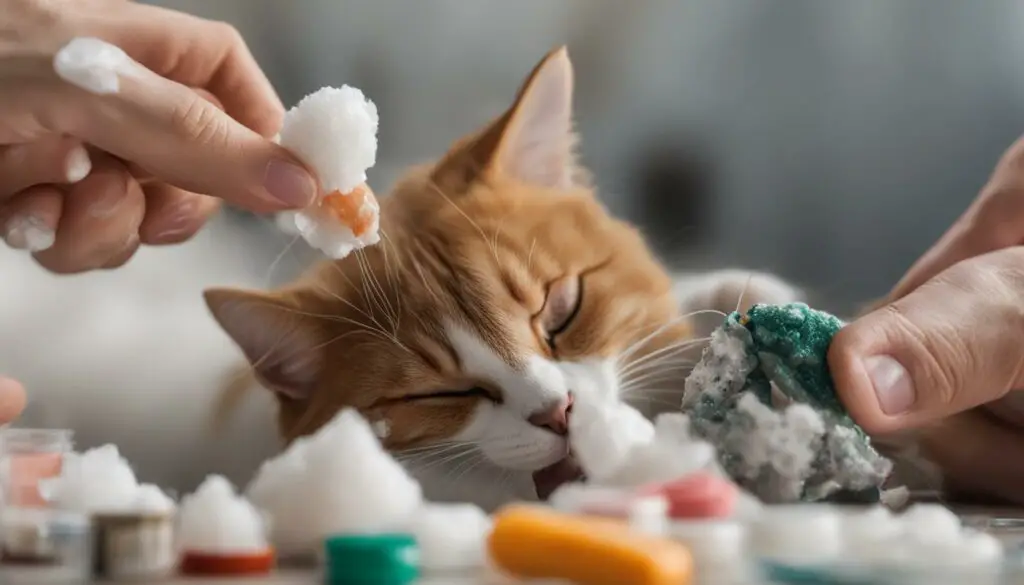Welcome to my blog post on supporting your cat after a traumatic dog attack. Cats can experience psychological trauma and exhibit various behaviors as a result. Understanding their behavior and implementing effective strategies can help them heal and regain their confidence. In this article, I will provide insights on cat behavior after a dog attack, post-traumatic stress disorder in cats, fear aggression, and techniques to calm and reintroduce traumatized cats. Let’s dive in!
Key Takeaways:
- Understanding cat behavior after a dog attack is crucial for providing appropriate support.
- Post-traumatic stress disorder (PTSD) can affect cats, leading to anxiety and fear aggression.
- Calming techniques such as creating a safe and enriching environment can aid in cat healing.
- Reintroducing traumatized cats must be done gradually and with care.
- Seeking professional help, such as cat therapy, can greatly benefit traumatized cats.
Signs of Emotional Trauma in Cats and Dogs
Emotional trauma can have a profound impact on both cats and dogs, leading to fear and anxiety disorders that can significantly affect their behavior and well-being. Recognizing the signs of emotional trauma is crucial in order to provide appropriate support and intervention for our beloved pets.
Signs of Emotional Trauma in Cats:
- Excessive hiding or isolating themselves
- Overreacting to sudden movements or noises
- Aggression or fear towards humans or other animals
- Loss of appetite or changes in eating habits
- Excessive grooming or self-harm
Signs of Emotional Trauma in Dogs:
- Persistent fear or anxiety in specific situations or environments
- Excessive barking, whining, or panting
- Aggression towards humans or other animals
- Repetitive or compulsive behaviors
- Loss of interest in activities or decreased energy levels
It’s important to note that the signs of emotional trauma can vary from one pet to another, and some may exhibit more subtle signs than others. If you suspect that your cat or dog may be experiencing emotional trauma, it’s essential to consult with a veterinarian or animal behaviorist for a thorough assessment and personalized treatment plan.

| Signs of Emotional Trauma in Cats | Signs of Emotional Trauma in Dogs |
|---|---|
| Excessive hiding or isolating themselves | Persistent fear or anxiety in specific situations or environments |
| Overreacting to sudden movements or noises | Excessive barking, whining, or panting |
| Aggression or fear towards humans or other animals | Aggression towards humans or other animals |
| Loss of appetite or changes in eating habits | Repetitive or compulsive behaviors |
| Excessive grooming or self-harm | Loss of interest in activities or decreased energy levels |
Causes of Aggression in Cats
Aggression in cats can stem from various factors, each requiring a specific approach for resolution. Understanding these causes is crucial in addressing aggression effectively.
Defensive Aggression
Cats may exhibit defensive aggression when they feel threatened or perceive danger. This can occur in response to unfamiliar people, animals, or situations. It is essential to create a safe and secure environment for the cat to minimize the triggers for defensive aggression.
Play Aggression
Play aggression is commonly seen in young cats and kittens. During play, cats may become overly excited and exhibit aggressive behavior, such as biting or scratching. Providing appropriate outlets for play, such as interactive toys and play sessions, can redirect their energy and prevent play aggression.
Frustration Aggression
Cats can display aggression when they experience frustration due to unmet needs or desires. This can occur when they are unable to access resources like food, water, or litter boxes. Ensuring that cats have easy access to these resources and addressing any underlying issues can help reduce frustration aggression.
Medical Causes
In some cases, aggression in cats may be caused by underlying medical conditions. Pain, hormonal imbalances, or neurological issues can contribute to aggressive behavior. It is essential to rule out any medical causes by consulting with a veterinarian and addressing them accordingly.
| Cause | Description |
|---|---|
| Defensive Aggression | Occurs when a cat feels threatened or perceives danger. |
| Play Aggression | Common in young cats and kittens during play sessions. |
| Frustration Aggression | Results from unmet needs or desires causing frustration. |
| Medical Causes | Underlying medical conditions contributing to aggressive behavior. |
Identifying the specific cause of aggression in cats is crucial for implementing appropriate strategies and creating a safe and harmonious environment for both the cat and its human companions.

Treating Emotional Trauma in Cats and Dogs
When it comes to treating emotional trauma in cats and dogs, there are several effective strategies that can help them recover and regain their well-being. One commonly used technique is desensitization and counter-conditioning. This involves gradually exposing the animal to the feared stimulus in a controlled and safe environment, while pairing it with positive experiences or rewards. For example, if a dog is traumatized by loud noises, such as fireworks, a desensitization program may involve playing recorded firework sounds at a very low volume while offering the dog treats or engaging in a favorite activity. Over time, the volume can be gradually increased as the dog becomes more comfortable and less reactive.
Medication can also be an important component of the treatment plan for pets with trauma. Just like humans, animals can benefit from medications that help regulate their anxiety and promote a sense of calm. However, it’s important to note that medication should always be used in conjunction with behavioral work and under the guidance of a veterinarian. Each animal is unique, and the specific medication and dosage should be tailored to their individual needs.
Desensitization and Counter-Conditioning for Pets
Desensitization and counter-conditioning can be effective for a range of traumas, including fear of other animals, separation anxiety, or even fear of specific objects or environments. By gradually exposing the pet to the trigger and pairing it with positive experiences, we can help them build new associations and alleviate their fear and anxiety.
| Steps for Desensitization and Counter-Conditioning |
|---|
| 1. Identify the trigger or stimulus that causes fear or anxiety. |
| 2. Start with a very diluted or distant version of the trigger. For example, if a cat is afraid of strangers, start with a video or audio recording of a stranger’s voice. |
| 3. Gradually increase the intensity or proximity of the trigger over time, always offering positive reinforcement and rewards. |
| 4. Continue the process until the pet can tolerate the trigger without fear or anxiety. |
| 5. Remember to go at the pet’s pace and never force them into a situation that causes extreme distress. |
Overall, treating emotional trauma in cats and dogs requires a combination of patience, understanding, and appropriate strategies. With the right approach and support, traumatized pets can heal and go on to live happy and fulfilling lives.

Coping Strategies for Living with a Traumatized Cat or Dog
Living with a traumatized pet can be challenging, but with the right strategies, you can help them heal and create a safe and comfortable environment for them. To prevent re-traumatization in pets, it’s crucial to understand their triggers and avoid exposing them to major stressors. By identifying and avoiding these triggers, you can minimize their anxiety and fears.
Creating a safe space for your traumatized cat or dog is essential. This can be a designated area in your home where they feel secure and have access to their basic needs such as food, water, and a comfortable bed. Make sure this space is quiet, away from loud noises or sudden movements that could startle them.
Avoiding triggers for traumatized pets is equally important. This means being mindful of their sensitivities and avoiding situations or stimuli that may evoke fear or anxiety. It’s crucial to observe their body language and behavior, as it can indicate when they’re uncomfortable or stressed. By being aware of these triggers, you can better manage their environment and prevent unnecessary distress.
| Strategies for Living with a Traumatized Cat or Dog |
|---|
| 1. Understand and avoid triggers |
| 2. Create a safe and comforting space |
| 3. Provide mental and physical stimulation |
| 4. Seek professional help if needed |
Additionally, providing mental and physical stimulation can help traumatized pets in their healing journey. Engage them in interactive play sessions, offer puzzle toys or food-dispensing toys to keep their minds occupied, and ensure they have regular exercise. These activities can help redirect their focus and energy in a positive way, promoting overall well-being.
If you find that your efforts are not yielding significant improvements or your traumatized pet’s behavior worsens, it may be necessary to seek professional help. A qualified veterinarian or animal behaviorist can offer guidance and create a tailored behavior modification plan specific to your pet’s needs. They can provide a deeper understanding of your pet’s trauma and assist in their recovery process.
Strategies for Helping Aggressive Cats
If you have a cat displaying aggressive behavior, it’s important to address the issue to ensure the safety and well-being of both your cat and those around them. Here are some strategies that can help you manage and reduce aggression in cats:
- Identify the underlying cause: Aggression in cats can stem from various reasons, such as defensive aggression, play aggression, or redirected aggression. Understanding the root cause of the aggression is essential in developing an effective management plan.
- Provide appropriate outlets for play aggression: Play aggression is a common form of aggressive behavior in cats, especially in younger cats. Encourage interactive play sessions with appropriate toys to redirect their aggressive energy.
- Create a safe and calm environment: Cats can become aggressive when they feel threatened or stressed. Ensure your cat has a safe space where they can retreat and relax. Minimize potential stressors in their environment and provide plenty of hiding spots and perches.
- Implement behavior modification techniques: Positive reinforcement training can be effective in modifying aggressive behaviors. Reward desirable behaviors and redirect their attention when they display aggression. Consult with a professional behaviorist for guidance.
By implementing these strategies and seeking professional help when needed, you can effectively manage and reduce aggression in your cat, helping them lead a happier and more peaceful life.

Case Study: Managing Defensive Aggression in Cats
“My cat, Luna, would become aggressive whenever someone approached her food bowl. It was causing tension in our household, and I was worried about her behavior. With the help of a behaviorist, we implemented a feeding routine that gradually desensitized Luna to people near her food. By creating a positive association and rewarding her calm behavior, Luna’s defensive aggression significantly reduced over time. Now, she can peacefully enjoy her meals without any issues.”
This case study highlights the importance of understanding and addressing the specific triggers that cause aggression in cats. With patience, consistency, and appropriate strategies, it is possible to manage and improve aggressive behavior in cats.
Strategies for Helping Aggressive Dogs
When dealing with aggressive behavior in dogs, it is important to identify the underlying cause and implement appropriate strategies to manage their aggression. Here are some effective approaches to help your aggressive dog:
1. Behavior Modification Techniques
Behavior modification techniques can be used to address fear, territorial, and defensive aggression in dogs. This involves gradually exposing the dog to the trigger that elicits aggressive behavior and rewarding them for displaying calm and non-aggressive responses. This process, known as desensitization and counter-conditioning, helps the dog associate positive experiences with previously feared situations.
2. Training
Training is crucial for managing aggression in dogs. Positive reinforcement training techniques, such as reward-based encouragement, can help redirect the dog’s focus and reinforce desired behaviors. It is important to work with a professional dog trainer who is experienced in handling aggression issues to ensure effective results.
3. Creating a Structured and Consistent Environment
Dogs thrive in a structured and consistent environment. Establish clear rules and boundaries for your dog and ensure everyone in the household follows them consistently. This helps provide a sense of security for the dog and reduces the likelihood of triggers that may lead to aggressive behavior.
| Aggression Type | Management Approach |
|---|---|
| Defensive Aggression | Desensitization and counter-conditioning, providing a safe space |
| Territorial Aggression | Behavior modification techniques, training, clear boundaries |
| Fear Aggression | Desensitization and counter-conditioning, positive reinforcement training |
Remember, addressing aggression in dogs requires patience, consistency, and professional guidance. It is essential to consult with a certified applied animal behaviorist or a veterinary behaviorist for a comprehensive assessment and a tailored behavior modification plan for your dog.
Seeking Professional Help for Aggressive Cats or Dogs
If your cat or dog is displaying aggressive behavior that is persistent or severe, it is important to seek professional help from a veterinary behaviorist or a certified applied animal behaviorist. These experts have the knowledge and experience to assess your pet’s behavior, determine the underlying cause of aggression, and develop a tailored behavior modification plan.
A veterinary behaviorist is a veterinarian who has undergone specialized training in animal behavior. They can provide a comprehensive evaluation of your pet’s physical and mental health, as well as recommend appropriate medications if necessary. A certified applied animal behaviorist specializes in understanding animal behavior and can offer expert advice on managing and modifying your pet’s aggressive behaviors.
Working with a professional can help you understand the root causes of aggression in your pet and provide you with effective techniques and strategies to address the issue. They can guide you through the behavior modification process, teach you how to communicate effectively with your pet, and help you create a safe and supportive environment.

Benefits of Seeking Professional Help
There are several benefits to seeking professional help for aggressive cats or dogs:
- Expertise: Veterinary behaviorists and certified applied animal behaviorists have extensive knowledge and experience in working with aggressive animals. They can provide accurate diagnoses and develop effective treatment plans.
- Customized Approach: Every cat or dog is unique, and what works for one may not work for another. Professionals can tailor their recommendations to suit your pet’s specific needs and personality.
- Increased Safety: Aggressive behavior in pets can be unpredictable and potentially dangerous. By seeking professional help, you can ensure the safety of both your pet and those around them.
Conclusion
Seeking professional help for aggressive cats or dogs is crucial in addressing the underlying causes of their aggression and finding effective solutions. Veterinary behaviorists and certified applied animal behaviorists have the expertise to guide you through the process and provide the support you need to improve your pet’s behavior and overall well-being.
Dealing with Cat Bites and Scratches
When a cat bites or scratches, it can cause injuries that may require medical attention. It’s essential to clean the wounds properly to prevent infection and promote healing. If you notice any signs of infection, such as redness, swelling, or discharge, it is crucial to seek medical advice.
When treating cat bites and scratches:
- Clean the wound with mild soap and warm water. Avoid using alcohol or peroxide, as they can delay healing.
- Apply an antiseptic solution or ointment to prevent infection.
- Cover the wound with a sterile bandage or dressing to protect it from further contamination.
If the wound does not heal or becomes increasingly painful, it is recommended to consult a healthcare professional. In some cases, a tetanus shot or antibiotics may be necessary to prevent complications.

Treating Cat Bite Infections
Cat bites can lead to infections due to the bacteria present in their mouths. The following signs may indicate an infection:
- Increased pain, warmth, or redness around the wound.
- Swelling or pus-like discharge.
- Fever or chills.
If you suspect an infection, it is essential to seek medical attention promptly. A healthcare professional can assess the severity of the infection and prescribe appropriate treatment, which may include antibiotics.
| Signs of Infection | Actions to Take |
|---|---|
| Increased pain, warmth, or redness around the wound. | Seek medical attention promptly. |
| Swelling or pus-like discharge. | Seek medical attention promptly. |
| Fever or chills. | Seek medical attention promptly. |
Preventing Aggression in Cats
To prevent aggression in cats, early socialization, positive reinforcement training, and providing environmental enrichment are key. By implementing these strategies, cat owners can create a positive and well-adjusted feline companion.
Socialization
Early socialization is essential in preventing aggression in cats. Introducing kittens to a variety of people, animals, and environments at a young age helps them develop confidence and adaptability. Gradual exposure to different stimuli, such as different sounds, surfaces, and experiences, can help prevent fear-based aggression later in life. It’s important to provide positive interactions during socialization, rewarding calm and friendly behavior with treats or play. Regular play sessions with interactive toys can also help cats build confidence and improve their social skills.
Positive Reinforcement Training
Positive reinforcement training involves rewarding desired behaviors to encourage their repetition. This training approach is effective in preventing aggression in cats. By rewarding cats for calm and appropriate behavior, such as using a scratching post instead of furniture or responding to cues like “sit” or “come,” owners can reinforce positive habits and discourage aggressive tendencies. Treats, praise, and playtime can be used as rewards during training sessions. It’s important to avoid punishment or physical aversion techniques, as these can increase fear and trigger defensive aggression.
Environmental Enrichment
Providing environmental enrichment is crucial in preventing aggression in cats. Cats thrive in an environment that offers mental and physical stimulation. Enrichment activities can include puzzle feeders, interactive toys, scratching posts, perches, and hiding places. These enrichments help cats engage in natural behaviors, relieve stress, and prevent boredom, which can contribute to aggression. Additionally, ensuring a consistent routine, proper litter box management, and access to vertical spaces can also help cats feel secure and reduce anxiety, decreasing the likelihood of aggressive behavior.
| Prevention Strategies | Description |
|---|---|
| Socialization | Introduce kittens to various people, animals, and environments to build confidence and adaptability. |
| Positive Reinforcement Training | Reward desired behaviors to encourage their repetition and discourage aggression. |
| Environmental Enrichment | Provide mental and physical stimulation through puzzle feeders, interactive toys, and vertical spaces. |
By implementing early socialization, positive reinforcement training, and environmental enrichment, cat owners can help prevent aggression and foster a harmonious relationship with their feline companions.

Preventing Aggression in Dogs
Dogs are social animals that thrive on companionship and positive interactions. By implementing preventive measures early on, we can help reduce the likelihood of aggression in dogs. Two key factors in preventing aggression are early socialization and positive reinforcement training.
Early socialization entails exposing puppies to various people, animals, and environments during their critical developmental period. This helps them become familiar with different stimuli and learn appropriate behaviors, ultimately reducing fear and anxiety. Introduce your puppy to different experiences gradually and positively, ensuring they associate these encounters with positive rewards and reinforcement.
Positive reinforcement training is another powerful tool in preventing aggression. This approach focuses on rewarding and encouraging desired behaviors while avoiding punishment or harsh correction. By rewarding dogs for displaying calm and non-aggressive behavior, we reinforce positive habits and build a strong bond of trust and respect.
Providing Physical and Mental Stimulation for Dogs
In addition to early socialization and positive reinforcement training, it’s crucial to provide dogs with ample physical and mental stimulation. Dogs need regular exercise, both physical and mental, to stay physically fit and mentally engaged. This can include daily walks, interactive play sessions, puzzle toys, and training activities.
Physical exercise helps release pent-up energy and prevents boredom, reducing the likelihood of frustration and aggression. Mental stimulation, such as obedience training and problem-solving games, challenges dogs’ minds and keeps them intellectually stimulated. By engaging their bodies and minds, we can help prevent behavioral issues and promote overall well-being.

| Preventive Measures | Description |
|---|---|
| Early Socialization | Expose puppies to various people, animals, and environments during their critical developmental period. |
| Positive Reinforcement Training | Reward and encourage desired behaviors while avoiding punishment or harsh correction. |
| Physical Exercise | Provide regular physical exercise to release energy and prevent boredom. |
| Mental Stimulation | Engage dogs in interactive play, puzzle toys, and training activities to keep them mentally engaged. |
Importance of Patience and Empathy in Helping Traumatized Pets
When it comes to supporting traumatized pets, patience and empathy play a crucial role in their healing process. Understanding the pet’s perspective is essential in providing the care and support they need. Traumatized pets often experience fear, anxiety, and various behavioral challenges as a result of their past experiences. By being patient and empathetic, we can help them feel safe and secure, allowing them to gradually recover and rebuild their trust.
Giving pets time to recover is another important aspect of helping them heal. Just like humans, animals need time to process their emotions and adjust to new environments. Rushing their recovery can lead to additional stress and setbacks. By allowing them the space and time they need, we can support their healing journey.
In our interactions with traumatized pets, it’s crucial to be gentle and understanding. Any form of forceful or harsh behavior can further traumatize them and hinder their progress. Instead, we should approach them with kindness, providing reassurance and positive reinforcement. By creating a calm and nurturing environment, we can help them feel safe and encourage their development of trust and confidence.

Creating a Safe and Enriching Environment for Pets
When it comes to our beloved pets, creating a safe and enriching environment is essential for their overall well-being. By providing them with a secure space and reducing potential stressors, we can help prevent anxiety and promote a happier and healthier life for our furry friends.
To ensure a safe environment for our pets, it’s important to identify any potential hazards and take appropriate measures to prevent accidents. This may include securing toxic substances, keeping electrical cords out of reach, and ensuring that windows and doors are properly secured. Additionally, providing a comfortable and cozy space for them to retreat to, such as a designated pet bed or crate, can give them a sense of security.
Aside from safety, it’s equally important to provide an enriching environment that stimulates their minds and bodies. This can be achieved through various means, such as interactive toys, puzzle feeders, and scratching posts for cats, or engaging toys and regular exercise for dogs. Incorporating mental and physical stimulation into their daily routine not only prevents boredom and destructive behaviors but also promotes a sense of fulfillment and happiness.

Reducing anxiety in pets can be achieved by establishing a consistent routine and providing them with plenty of love and affection. Pets thrive on routine, so maintaining a regular schedule for feeding, exercise, and playtime can greatly reduce their stress levels. Additionally, creating a calm and peaceful environment by minimizing loud noises, such as fireworks or thunderstorms, can help reduce anxiety in pets.
In conclusion, creating a safe and enriching environment for our pets is crucial for their overall well-being. By taking the necessary steps to provide a secure and stimulating space, we can prevent stress, reduce anxiety, and promote a happy and fulfilling life for our furry companions.
The Role of Positive Reinforcement in Training and Rehabilitation
When it comes to training and rehabilitating traumatized pets, positive reinforcement plays a crucial role. Unlike punitive methods that rely on fear and intimidation, positive reinforcement focuses on rewarding desired behaviors, building trust, and promoting positive interactions with pets.
Through reward-based encouragement, pets are motivated to engage in behaviors that are desirable and appropriate. This can be achieved by offering treats, praise, or playtime when the pet exhibits the desired behavior. By associating positive experiences with specific actions, pets learn to repeat those behaviors, leading to lasting change and improved overall well-being.
“Positive reinforcement training is not only effective but also fosters a nurturing and supportive environment for traumatized pets,” says Dr. Jane Myers, a certified animal behaviorist. “It allows them to rebuild trust and confidence, which are essential for their emotional healing.”
In addition to training, positive reinforcement helps create positive interactions with pets. This includes establishing a bond based on trust and respect, engaging in activities that the pet enjoys, and providing a safe and secure environment. By focusing on positive experiences and building a strong connection, traumatized pets can overcome their fears and anxieties, ultimately leading to a happier and more fulfilling life.
| Benefits of Positive Reinforcement in Training and Rehabilitation |
|---|
| 1. Builds trust and strengthens the human-animal bond |
| 2. Promotes positive behaviors and reduces aggression |
| 3. Creates a nurturing and supportive environment |
| 4. Enhances the pet’s overall well-being and quality of life |
It’s important to note that positive reinforcement should be used in conjunction with other appropriate techniques and strategies. Each pet is unique, and their rehabilitation journey may require a tailored approach. Consulting with a professional, such as a certified applied animal behaviorist, can provide valuable guidance and ensure the best outcomes for the pet.

Conclusion
In conclusion, supporting traumatized pets requires a compassionate and patient approach. By understanding their perspective and providing them with the necessary care, we can help them overcome their fears and anxieties. Here are some important tips for helping traumatized pets:
1. Create a safe and calm environment:
Set up a designated safe space where your pet can retreat to when they feel overwhelmed. Minimize loud noises and avoid potential triggers that may cause them distress. Creating a peaceful atmosphere will help them feel secure and supported.
2. Seek professional help if needed:
If your pet’s trauma-related behaviors persist or worsen, it is advisable to consult with a veterinary behaviorist or certified applied animal behaviorist. These professionals can provide a thorough assessment and develop a tailored behavior modification plan to address your pet’s specific needs.
3. Use positive reinforcement and patience:
Utilize positive reinforcement training techniques to encourage good behavior and reward your pet’s progress. Building trust takes time, so practice patience and understanding throughout the rehabilitation process. Remember that small steps of improvement should be celebrated and encouraged.
4. Maintain a consistent routine:
Establishing a consistent daily routine can help your pet feel more secure and reduce their anxiety. Stick to regular feeding times, exercise routines, and play sessions. Consistency provides predictability and stability, which can be reassuring for traumatized pets.
By following these tips and offering your traumatized pet the support they need, you can help them heal and regain their confidence and resilience. Remember, every small step counts towards their well-being and quality of life.
FAQ
What are the signs of emotional trauma in cats and dogs?
Signs of emotional trauma in cats and dogs can include attempted escape, aggression, freezing, hiding, excessive vocalization, pacing, and panting.
What causes aggression in cats?
Aggression in cats can be caused by various factors including perceived threat or danger, play behavior that becomes rough, frustration, or underlying medical conditions.
How is emotional trauma in animals treated?
Emotional trauma in animals can be treated using techniques such as desensitization and counter-conditioning, as well as medication prescribed by a veterinarian to complement behavioral work.
How can I create a safe and calming environment for a traumatized cat or dog?
Creating a safe and calming environment for a traumatized pet involves understanding their triggers, avoiding major stressors, and providing a calm and secure space for them to heal.
What strategies can I use to help manage aggression in cats?
Strategies for managing aggression in cats include identifying the underlying cause, providing appropriate outlets for play aggression, redirecting aggression towards appropriate targets, and creating a safe and calm environment.
How can I help my aggressive dog?
Helping an aggressive dog involves identifying the underlying cause, implementing behavior modification techniques, training, and creating a structured and consistent environment.
When should I seek professional help for my cat or dog’s aggression?
If your cat or dog’s aggression persists or is severe, it is important to seek professional help from a veterinary behaviorist or certified applied animal behaviorist for a thorough assessment and tailored behavior modification plan.
What should I do if I get bitten or scratched by a cat?
If you are bitten or scratched by a cat, it is important to clean the wounds properly and seek medical advice if necessary, as cat bites can lead to infections.
How can I prevent aggression in cats?
Preventing aggression in cats involves early socialization, positive reinforcement training, and providing environmental enrichment to create a positive and well-adjusted cat.
How can I prevent aggression in dogs?
Preventing aggression in dogs involves early socialization, positive reinforcement training, and providing physical and mental stimulation to create a well-behaved and balanced dog.
What is the importance of patience and empathy in helping traumatized pets?
Patience and empathy are crucial in helping traumatized pets as it allows for understanding their perspective, giving them time to recover, and being gentle with them to aid in their healing process.
How can I create a safe and enriching environment for my pets?
Creating a safe and enriching environment for pets involves providing appropriate shelter, avoiding potential stressors, and offering mental and physical stimulation to reduce anxiety and improve their overall well-being.
What role does positive reinforcement play in training and rehabilitation?
Positive reinforcement training and reward-based encouragement are effective techniques in training and rehabilitating traumatized pets as they help build trust and foster positive interactions.
Why is seeking professional help important for aggressive cats or dogs?
Seeking professional help from a veterinary behaviorist or certified applied animal behaviorist is important for aggressive cats or dogs as they can provide a thorough assessment and develop a tailored behavior modification plan.
What should I do if I get bitten or scratched by a cat?
If you get bitten or scratched by a cat, it is important to clean the wounds properly and seek medical advice if necessary, as cat bites can lead to infections.
How can I prevent aggression in cats?
Preventing aggression in cats involves early socialization, positive reinforcement training, and providing environmental enrichment to create a positive and well-adjusted cat.








